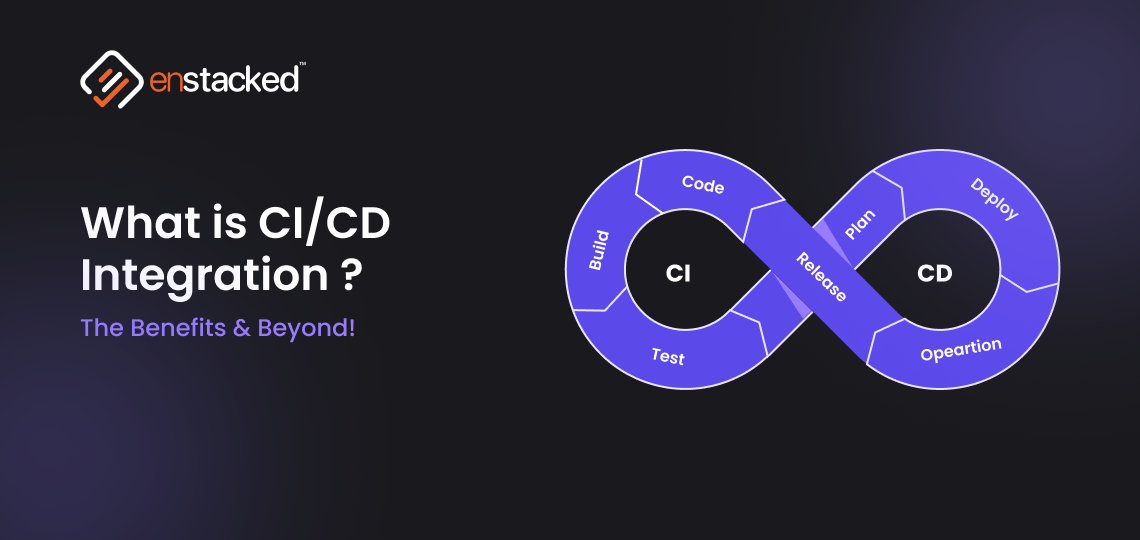In today’s digital world, all businesses operate as software companies, regardless of their industry. In addition to the products you are developing, end customers, clients, and workers want software updates on a regular basis.
Therefore, you need to make an investment to increase the efficiency of your development teams, regardless of the industry in which your business operates. The best method to do this is via DevOps. And, of course, a Continuous Integration/Continuous Delivery (CI/CD) pipeline is the most crucial component that teams need for DevOps.
Making changes to source code does not have to be a manual, time-consuming waterfall procedure. Continuous integration and continuous delivery (CI/CD) allow software development, testing, and security teams to modify, test, and distribute source code updates many times per day.
Now let’s examine the definition of the CI/CD pipeline and the advantages it offers to companies.

During Continuous integration (CI)
Developers regularly merge code changes into a shared repository. In order to swiftly detect any integration problems, this starts an automated development and testing procedure.
Continuous Delivery(CD)
automates the release process, extending Continuous Integration (CI). It guarantees that the program is consistently in a deployable state, prepared for prompt delivery to operational settings.
Implementing CICD can help developers increase productivity, improve code quality, and shorten the release cycle. It allows for quicker and more dependable software delivery, which makes it easier for team members to collaborate and react quickly to client needs.
Both components mostly rely on automation to get rid of laborious human operations, which lowers errors and guarantees high-quality software engineering. Thus, essentially, a pipeline for continuous integration and Deployment (CI/CD) offers a set of actions for automated software delivery.

The Top 10 Benefits of Implementing the CI/CD Pipeline!
Increase the operational speed
Automation and shorter feedback loops may be contributing to faster product iteration. Automation gives DevOps technicians up-to-date knowledge about a build’s viability.
It’s reduced CI integrations and CD deployments boost DevOps KPIs like Mean Time To Resolution (MTTR). MTTR measures the typical time required to resolve faults and malfunctioning features, including identifying underlying problems. The total CI/CD process shortens the time needed to troubleshoot, test, create, and deploy an application.
Efficient Infrastructure
Any CI/CD pipeline must include automation at its core to ensure a dependable and repeatable release process. Writing and executing automated tests as well as automating the build process, will be your main priorities when first adopting continuous integration.
The next step is to automate the deployment of your build to test and staging environments after you’ve built a strong basis for continuous integration. When using an infrastructure-as-code methodology, the process of creating those environments is automated.
Rather than manually managing individual servers, their configuration is automated and kept in version control, allowing new environments to be brought online rapidly and without the danger of unintentional changes and inconsistencies. This enables you to promptly reply to requests with the least disruption to development work and helps you accelerate and strengthen the continuous delivery stage.
Improved Code Quality
CI/CD enhances code quality by incorporating automated tests at each integration step, catching bugs and issues early in the development process. It ensures that the codebase remains stable and reliable throughout and after the deployment.
Additionally, CI/CD pipelines can include code reviews and static analysis tools, further elevating the quality of the code. Regular automated CI/CD integration testing helps identify potential problems early while also ensuring that new code changes do not disrupt existing functionalities, leading to a more robust and maintainable codebase.
Higher Scalability
CI/CD pipelines are designed to handle large volumes of code changes and deployments, making them highly scalable. As your business grows, the pipeline can be adjusted to manage the increased load without compromising performance.
Integration of Infrastructure as Code (IaC) within the CI/CD pipeline further allows for scalable and repeatable infrastructure deployments. This scalability ensures that the development process can keep pace with the growth of the business and the increasing demands of the user base.
Prevent disruptions
Your DevOps teams can continuously integrate small batches of code rather than the full application with the help of an effective CI/CD pipeline. This method makes it easier for the developers to find and address irregularities. Through this, you can prevent major outages and other critical concerns by identifying bugs and vulnerabilities before they reach production and cause problems to the entire application.
Better problem awareness during the development
Software developers could quickly identify whether there was a problem with the code before DevOps methodology and CI/CD approaches were introduced. However, they had trouble pinpointing the precise location of the issue. The CI/CD integration testing with automated testing procedures has now increased visibility across the software development lifecycle.
Create extensive logs
One of the main components of the integration of CI/CD and DevOps is observability. If something isn’t right, you should know why. One technical tool that aids in this endeavor is observability. Information logging is a crucial component of observability.
Logs are a rich source of data that may be used to analyze application behavior and comprehend what is going on behind the scenes. A continuous integration/continuous development pipeline generates copious amounts of logging data at every development stage. There are a variety of CI/CD integration tools available to successfully examine these logs and provide fast feedback on the system
Rolling back changes is simpler
One of the most significant advantages of using a CI/CD pipeline is the ability to swiftly roll back changes. You can quickly restore the production application to its former state in case any new code modifications cause issues. To avoid production downtime, the most recent successful build is often deployed right away.
Rapid release cycles are becoming the norm in the globe, and CI/CD pipelines have sped up the velocity of release. Such a pipeline can help you detect issues more quickly, apply repairs right away, and improve overall customer satisfaction with proper planning and execution.
Reducing failures and risk.
CI/CD offers multiple levels of security and protection during the development and deployment phases of the lifecycle. The cumulative effect of these fail-safe and fail-smart procedures decreases the risk that software development teams experience when producing viable code.
The built-in automation and automated CI/CD integration testing promote continuous testing using methods such as unit testing, integration testing, regression testing, and so on. Additionally, throughout the build phase, CI/CD systems send out a variety of warnings to site engineers and IT managers informing them when something goes wrong.
Reduce the need for manual debugging
Testing & troubleshooting the code is the most crucial part of developing software. Testing is the main cause of the delays in the releases, which leads to slower time-to-market and lost opportunities. Delayed releases have an influence not only on the time to market, but also on the cost, branding, and reputation of the brand.
Software CI/CD integration testing and debugging were done manually, a laborious procedure, prior to DevOps and CI/CD. But, with the CI/CD implementation and its automated capabilities, the manual debugging of the software decreases which leads to faster CI/CD integration testing and deployment.
Integrate CI/CD into your workflow right away!
CI/CD pipelines are a crucial component of contemporary software development and help in the development of exceptional software in the quick-paced software industry. The line between development and operations is blurred as continuous integration and continuous delivery (CI/CD) advances, freeing up developers to concentrate on improving business applications.
After going over the fundamentals and advantages, we hope it’s obvious that a CI/CD pipeline is essential for companies looking to boost ROI and speed up software delivery. Building a successful CI/CD pipeline, however, can be difficult and complex and help you achieve all of the above-mentioned benefits.
However, you can get the best CI/CD integration solutions for your business needs by working with the top enterprise development company as your partner.
At Enstacked, we specialize in helping businesses harness the power of CI/CD. Our expert team can guide you through the implementation process, ensuring that your development pipeline is optimized for speed, reliability, and scalability.
Frequently Asked Questions(FAQs)
1. Searchability
- Small-scale, straightforward projects with quick development cycles and little complexity.
- Legacy systems are constructed using antiquated technology or without appropriate version control.
- Research or experimental endeavors requiring adaptability and quick prototyping
- Budgetary restrictions or scarce resources that prevent funding for CI/CD implementation
2. How does CI/CD impact the overall software development lifecycle?
CI/CD positively impacts the software development lifecycle by promoting frequent integration and continuous delivery of updates. This results in shorter development cycles, quicker release times, and the ability to respond swiftly to market changes and customer feedback.
3. What are the prerequisites for implementing CI/CD?
The prerequisites for implementing CI/CD include having a version control system, a reliable build environment, automated testing frameworks, and a CI/CD integration tool. Additionally, a culture that embraces automation, collaboration, and continuous improvement is essential.
4. What are the challenges of implementing CI/CD?
The challenges of implementing CI/CD include the initial setup and configuration, the need for a cultural shift towards automation and collaboration, and ensuring that automated tests are comprehensive and reliable. Continuous monitoring and maintenance of the CI/CD pipeline are also necessary to keep it effective.


